E.G. Wolverson's Blog, page 6
January 31, 2019
Book Review | Fire & Blood by George R R Martin
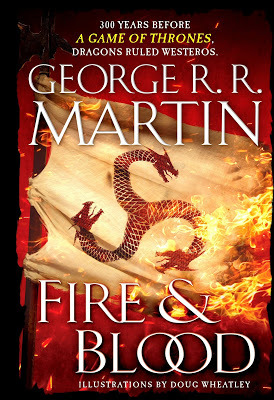 Unfortunately when it comes to George R R Martin’s most recent literary offering, more people are talking about what it isn’t rather than what it is. Neither the long-awaited sixth entry in
A Song of Ice and Fire
nor even a novel at all, Fire & Blood is actually the first of two in-world histories ostensibly penned by the Citadel’s Archmaester Gyldayn. Likened by many to J R R Tolkien’s Silmarillion, Fire & Blood is an historical account of the hundred and fifty years that followed Aegon the Conqueror’s conquest of Westeros, with especial focus on the dragon lords whose infamous credo lends the work its title.
Unfortunately when it comes to George R R Martin’s most recent literary offering, more people are talking about what it isn’t rather than what it is. Neither the long-awaited sixth entry in
A Song of Ice and Fire
nor even a novel at all, Fire & Blood is actually the first of two in-world histories ostensibly penned by the Citadel’s Archmaester Gyldayn. Likened by many to J R R Tolkien’s Silmarillion, Fire & Blood is an historical account of the hundred and fifty years that followed Aegon the Conqueror’s conquest of Westeros, with especial focus on the dragon lords whose infamous credo lends the work its title.Whilst I share the disillusionment of those frothing at the mouth in their desperation to read The Winds of Winter, it’s impossible to feel let down by Fire & Blood, which is - by far - Martin’s finest offering since his seminal, mammoth novel A Storm of Swords in 2000. The author has spoken openly about the difficulties that he is having dealing with the scope and complexity of Winds; it’s seems to be more of a weight around his neck than the labour of love that Fire & Blood clearly has been. The imaginative fervour often missing from A Feast for Crows and particularly A Dance with Dragons is back in earnest in this volume; Martin seems to have delighted in expanding, enriching and inventing the already vivid history behind his flagship saga.
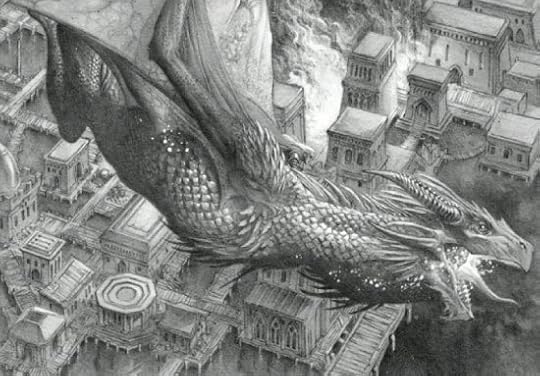 Fire & Blood is illustrated in stunning fashion by Doug Wheatley
Fire & Blood is illustrated in stunning fashion by Doug WheatleyAlready being familiar with Aegon Targaryen’s conquest of Westeros, the legendary Dance of the Dragons and other key events from Targaryen history thanks to Game of Thrones ’ grand animated features (such as the feature-length Conquest & Rebellion and the Blu-rays’ fascinating Histories and Lore segments), not to mention The World of Ice & Fire, I worried that Fire & Blood might just retread old ground in fusty, maesterly prose. And inevitably, familiar subjects do eat up much of the page count. In fact, in some cases entire passages have seen print before, albeit in comparatively obscure anthologies, with the notable exception of the “The Targaryen Conquest”, which seems to be an almost direct lift from The World of Ice & Fire.
Even when revisiting well-trodden ground, though, Fire & Blood often offers hitherto unparalleled levels of detail from various (and often conflicting) sources, all of whom our lofty scribe has thinly-veiled opinions about. Amongst the most memorable of these are Mushroom, an insightful and perverse king’s fool who, if Gyldayn is to be believed, is prone to hyperbole if not outright fancifulness, and of course the well-respected and scholarly Archmaester Orwyle, from whose journals Grand Maester Munkun would later set down his much-revered (by Gyldayn, at least) True Telling. On top of this, Gyldayn often reinterprets events in an attempt to rob them of their imprecise poetry, notably rechristening the Dance of the Dragons “The Dying of the Dragons” despite the prevalence of the name, and questioning the accuracy of every so-called Dornish war (scant few of which were actually sanctioned by those ruling the Sunset Kingdom, it seems).

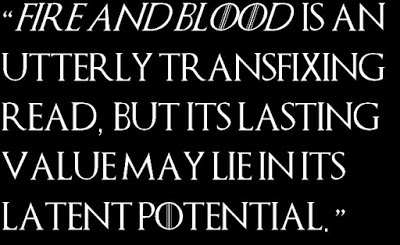 Of more interest to me, though (and I dare say to Martin, too, given the pages allocated to their reigns), are little-known rulers the like of King Jaehaerys I, the Concilliator, and his Good Queen Alysanne, whose exploits as sketched out here could easily give rise to multiple seasons of a politically thrilling Game of Thrones-style TV show. Dornish wars, vulture kings, wayward daughters, vagabond dragons and even monstrous parasites from Volantis all punctuate what is regarded by Gyldayn as the most peaceful and prosperous period in Westerosi history. Gaps are plugged not only satisfactorily, but thrillingly, as Jaehaerys’s reign melts into Viserys’s and Gyldayn turns his attention to the laws of succession and the sexism underpinning them that unwittingly sparked the Dance - sorry, the Dying - of the Dragons. In many ways the prelude to the great internecine conflict is even more fascinating than the epic conflict itself (a problem that Game of Thrones has wrestled with as its addictive politicking has slowly segued into all-out war), as is its aftermath as Gyldayn’s focus is turned to the dragon-slaying Shepherd and the brief reigns of the so-called three kings during the Moon of Madness.
Of more interest to me, though (and I dare say to Martin, too, given the pages allocated to their reigns), are little-known rulers the like of King Jaehaerys I, the Concilliator, and his Good Queen Alysanne, whose exploits as sketched out here could easily give rise to multiple seasons of a politically thrilling Game of Thrones-style TV show. Dornish wars, vulture kings, wayward daughters, vagabond dragons and even monstrous parasites from Volantis all punctuate what is regarded by Gyldayn as the most peaceful and prosperous period in Westerosi history. Gaps are plugged not only satisfactorily, but thrillingly, as Jaehaerys’s reign melts into Viserys’s and Gyldayn turns his attention to the laws of succession and the sexism underpinning them that unwittingly sparked the Dance - sorry, the Dying - of the Dragons. In many ways the prelude to the great internecine conflict is even more fascinating than the epic conflict itself (a problem that Game of Thrones has wrestled with as its addictive politicking has slowly segued into all-out war), as is its aftermath as Gyldayn’s focus is turned to the dragon-slaying Shepherd and the brief reigns of the so-called three kings during the Moon of Madness.Perhaps it’s in such detailed and dynamic digressions that Martin’s genius is most evident. Fire & Blood, in of itself, is an utterly transfixing read, but its lasting value may lie in its latent potential. The Winds of Winter could arrive tomorrow and it would be too late to exert any influence on Game of Thrones’ final season, which is in the can and currently being edited for its spring broadcast. Fire & Blood, on the other hand, offers HBO a blueprint for not just multiple seasons, but multiple series of lucrative, premium television. It may have been Jane Goldman’s series set during the Long Night that HBO picked up for a pilot, but in the wake of this masterwork I would be astonished if they didn’t put multiple Targaryen shows into immediate development.
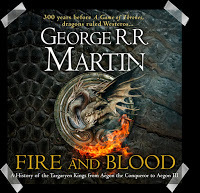 Fire & Blood is available to download from
iTunes’ iBooks Store
and
Amazon
for £7.99. A hardback copy is also available, with today’s cheapest retailer being
Amazon
, who have it listed at £13.00. An audiobook read by Simon Vance is also available to download from
iTunes’ iBooks Store
for £17.99 and
Audible
for £26.99.
Fire & Blood is available to download from
iTunes’ iBooks Store
and
Amazon
for £7.99. A hardback copy is also available, with today’s cheapest retailer being
Amazon
, who have it listed at £13.00. An audiobook read by Simon Vance is also available to download from
iTunes’ iBooks Store
for £17.99 and
Audible
for £26.99. A CD version is harder to source in the UK - and about twice the price of the digital download. Despite the format, this version still includes Doug Wheatley’s accompanying illustrations as a separate download.
Published on January 31, 2019 15:39
Book Review | Fire & Blood by George RR Martin
 Unfortunately when it comes to George RR Martin’s most recent literary offering, more people are talking about what it isn’t rather than what it is. Neither the long-awaited sixth entry in
A Song of Ice and Fire
nor even a novel at all, Fire & Blood is actually the first of two in-world histories ostensibly penned by the Citadel’s Archmaester Gyldayn. Likened by many to JRR Tolkien’s Silmarillion, Fire & Blood is an historical account of the hundred and fifty years that followed Aegon the Conqueror’s conquest of Westeros, with especial focus on the dragon lords whose infamous credo lends the work its title.
Unfortunately when it comes to George RR Martin’s most recent literary offering, more people are talking about what it isn’t rather than what it is. Neither the long-awaited sixth entry in
A Song of Ice and Fire
nor even a novel at all, Fire & Blood is actually the first of two in-world histories ostensibly penned by the Citadel’s Archmaester Gyldayn. Likened by many to JRR Tolkien’s Silmarillion, Fire & Blood is an historical account of the hundred and fifty years that followed Aegon the Conqueror’s conquest of Westeros, with especial focus on the dragon lords whose infamous credo lends the work its title.Whilst I share the disillusionment of those frothing at the mouth in their desperation to read The Winds of Winter, it’s impossible to feel let down by Fire & Blood, which is - by far - Martin’s finest offering since his seminal A Storm of Swords in 2000. The author has spoken openly about the difficulties that he is having dealing with the scope and complexity of Winds; it’s seems to be more of a weight around his neck than the labour of love that Fire & Blood clearly has been. The imaginative fervour often missing from A Feast for Crows and particularly A Dance with Dragons is back in earnest in this volume; Martin seems to have delighted in expanding, enriching and often inventing the already vivid history behind his flagship saga.
 Fire & Blood is illustrated in stunning fashion by Doug Wheatley
Fire & Blood is illustrated in stunning fashion by Doug WheatleyAlready being familiar with Aegon Targaryen’s well-documented conquest of Westeros, the legendary Dance of the Dragons and other key events from Targaryen history thanks to Game of Thrones ’ grand animated features (such as the feature-length Conquest & Rebellion and the Blu-rays’ Histories and Lore segments), not to mention The World of Ice & Fire, I worried that Fire & Blood might just retread old ground in fusty, maesterly prose. And inevitably, familiar subjects do eat up much of the page count. In fact, in some cases entire passages have seen print before, albeit in comparatively obscure anthologies, with the notable exception of the “The Targaryen Conquest” which seems to be an almost direct lift from The World of Ice & Fire.
Even when revisiting well-trodden ground, though, Fire & Blood offers hitherto unparalleled levels of detail from various (and often conflicting) sources, all of whom our lofty scribe has thinly-veiled opinions about. Amongst the most memorable of these are Mushroom, an insightful and perverse king’s fool who, if Gyldayn is to be believed, is prone to hyperbole if not outright fancifulness, and of course the well-respected and scholarly Archmaester Orwyle, from whose journals Grand Maester Munkun would later set down his much-revered (by Gyldayn, at least) True Telling. On top of this, Gyldayn often reinterprets events in an attempt to rob them of their imprecise poetry, notably rechristening the Dance of the Dragons “The Dying of the Dragons” despite its prevalence and questioning the accuracy of the label attached to almost every Dornish War (scant few of which were sanctioned by those ruling the Sunset Kingdom).

Of more interest to me, though (and I dare say to Martin, too, given the pages allocated to their reigns), are little-known rulers the like of King Jaehaerys I, the Concilliator, and his Good Queen Alysanne, whose exploits as sketched out here could easily give rise to multiple seasons of a politically thrilling Game of Thrones-style show. Dornish Wars, Vulture Kings, wayward daughters, missing dragons and even monstrous parasites from Volantis all punctuate what is regarded by Gyldayn as the most peaceful and prosperous period in Westerosi history. Gaps are plugged not only satisfactorily, but thrillingly, as Jaehaerys’s reign melts into Viserys’s and Gyldayn turns his attention to the laws of succession and the sexism underpinning them that unwittingly sparked the Dance - sorry, the Dying - of the Dragons. In many ways the prelude to the great internecine conflict is even more fascinating than the epic conflict itself (a problem that Game of Thrones has wrestled with as its addictive politicking has slowly segued into all-out war), as is its aftermath as Gyldayn’s focus is turned to the dragon-slaying Shepherd and the brief reigns of the so-called three kings during the Moon of Madness.
Perhaps it’s in such detailed and dynamic digressions that Martin’s genius is most evident. Fire & Blood, in of itself, is an utterly transfixing read, but its lasting value may lie in its latent potential. The Winds of Winter could arrive tomorrow and it would be too late to exert any influence on Game of Thrones’ final season, which is in the can and currently being edited for its spring broadcast. Fire & Blood, on the other hand, offers HBO a blueprint for not just multiple seasons, but multiple series of lucrative, premium television. It may be Jane Goldman’s series set during the Long Night that HBO have picked up for a pilot, but in the wake of this masterwork I would be astonished if they didn’t put multiple Targaryen shows into immediate development.
 Fire & Blood is available to download from
iTunes’ iBooks Store
and
Amazon
for £7.99. A hardback copy is also available, with today’s cheapest retailer being
Amazon
, who have it listed at £13.00. An audiobook read by Simon Vance is also available to download from
iTunes’ iBooks Store
for £17.99 and
Audible
for £26.99.
Fire & Blood is available to download from
iTunes’ iBooks Store
and
Amazon
for £7.99. A hardback copy is also available, with today’s cheapest retailer being
Amazon
, who have it listed at £13.00. An audiobook read by Simon Vance is also available to download from
iTunes’ iBooks Store
for £17.99 and
Audible
for £26.99. A CD version is harder to source in the UK - and about twice the price of the digital download. Despite the format, this version still includes Doug Wheatley’s accompanying illustrations as a separate download.
Published on January 31, 2019 15:39
December 31, 2018
Rants | When More is Less: Introducing 2:1
Some people like to end the year with a reflection on thankfulness; I’m more disposed towards ending it with a rant. Whilst on a personal level I’ve had a great twelve months, the world is in an even more shocking state than it was before. In his recent live show Humanity, Ricky Gervais talks about how in the past couple of years, for the first time in his life, civilisation has started to slip into decline. I agree, and think this is most evident in the sudden outbreak of the 18:9 (2:1) aspect ratio across television. People are so wrapped up in their worries over our failing government and the looming possibility of a no-deal Brexit, 2:1 has insidiously slipped in under the radar, undermining living-room tellies nationwide and ruining countless Christmases - mine chief amongst them.
 The
Star Trek: Discovery
Blu-ray,
Doctor Who
,
Click & Collect
,
The ABC Murders
and just about every other major prime-time programme that I’ve watched over the last month has been missing 230,400 live pixels as their producers have embraced the chic new “cinematic” aspect ratio that’s unfriendly to even the newest 4K HDR TVs. It’s a good job my TV screen is 41.7” x 23.5” (a 50-incher when measuring from corner to corner as TV manufacturers obviously do) to start with as its watchable area is reduced to 41.7” x 20.85” with these programmes – that’s 110.5”2 of missing picture by my reckoning.
The
Star Trek: Discovery
Blu-ray,
Doctor Who
,
Click & Collect
,
The ABC Murders
and just about every other major prime-time programme that I’ve watched over the last month has been missing 230,400 live pixels as their producers have embraced the chic new “cinematic” aspect ratio that’s unfriendly to even the newest 4K HDR TVs. It’s a good job my TV screen is 41.7” x 23.5” (a 50-incher when measuring from corner to corner as TV manufacturers obviously do) to start with as its watchable area is reduced to 41.7” x 20.85” with these programmes – that’s 110.5”2 of missing picture by my reckoning.
 What’s most irritating of all though are the long-term implications of this. Even if the next generation of TVs base their screen dimensions on the 2:1 aspect ratio, then legacy 2:1 media is still going to appear both letterboxed and pillarboxed on their displays, as current Blu-ray standards insist upon a 1920 x 1080 frame (3840 x 2160 for UHD) and iTunes downloads (probably Amazon etc too, though I can’t speak to this) adhere to the same conventions. This means that a 2:1 image is locked into its frame between two black bars, and so if it’s ever viewed on a 2:1 screen, then the only way it could fill that screen would be if it were enlarged, resulting in a softer and incomplete picture. It’d be like it was watching a 2.35:1-letterboxed-in-4:3 VHS movie blown up on an early CRT widescreen telly - unremittingly bloody awful.
What’s most irritating of all though are the long-term implications of this. Even if the next generation of TVs base their screen dimensions on the 2:1 aspect ratio, then legacy 2:1 media is still going to appear both letterboxed and pillarboxed on their displays, as current Blu-ray standards insist upon a 1920 x 1080 frame (3840 x 2160 for UHD) and iTunes downloads (probably Amazon etc too, though I can’t speak to this) adhere to the same conventions. This means that a 2:1 image is locked into its frame between two black bars, and so if it’s ever viewed on a 2:1 screen, then the only way it could fill that screen would be if it were enlarged, resulting in a softer and incomplete picture. It’d be like it was watching a 2.35:1-letterboxed-in-4:3 VHS movie blown up on an early CRT widescreen telly - unremittingly bloody awful.
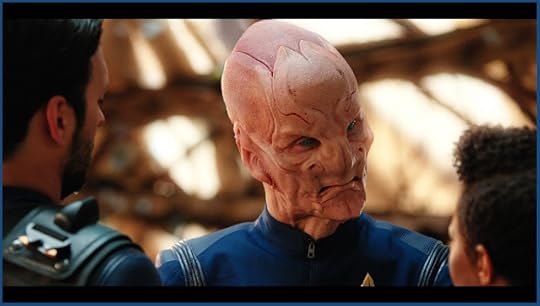
 Apologists for 2:1 argue that there is no cause for concern as most modern TVs allow for custom zooming, giving naysayers like me the option to zoom in on the letterboxed image. Whilst this is true, it does not account for the fact that zooming loses the outer edges of the image - or that it’s a right bloody faff. I have my custom zoom set to automatically blow 2.35:1 movies up to 16:9, losing the edges off the picture but filling up my screen, and I don’t begrudge this one bit as films are made - at least for now - for cinema exhibition, and I can easily flick back and forth between 16:9 and 2.35:1 almost as effortlessly as if I were watching a Christopher Nolan or Michael Bay film (in which case I don’t have to press anything at all to see the aspect ratio shift from scene to scene). However, if I alter this setting to blow a 2:1 Discovery or Who up to 16:9, I’m going to have to tweak my zoom settings every time I watch a movie. Moreover, when zooming in on a movie I’m usually blowing up an incredibly detailed UHD image, and as a result any softening of the picture is imperceptible - at least on a 50” screen situated six feet away from me. But blowing up a 720p BBC iPlayer stream yields an only slightly sharper than DVD picture, which is surely at odds with the lofty ambitions of the producers who’ve adopted 2:1. Even zooming in on the otherwise stunning 1080p Discovery Blu-ray adversely affected the image quality.
Apologists for 2:1 argue that there is no cause for concern as most modern TVs allow for custom zooming, giving naysayers like me the option to zoom in on the letterboxed image. Whilst this is true, it does not account for the fact that zooming loses the outer edges of the image - or that it’s a right bloody faff. I have my custom zoom set to automatically blow 2.35:1 movies up to 16:9, losing the edges off the picture but filling up my screen, and I don’t begrudge this one bit as films are made - at least for now - for cinema exhibition, and I can easily flick back and forth between 16:9 and 2.35:1 almost as effortlessly as if I were watching a Christopher Nolan or Michael Bay film (in which case I don’t have to press anything at all to see the aspect ratio shift from scene to scene). However, if I alter this setting to blow a 2:1 Discovery or Who up to 16:9, I’m going to have to tweak my zoom settings every time I watch a movie. Moreover, when zooming in on a movie I’m usually blowing up an incredibly detailed UHD image, and as a result any softening of the picture is imperceptible - at least on a 50” screen situated six feet away from me. But blowing up a 720p BBC iPlayer stream yields an only slightly sharper than DVD picture, which is surely at odds with the lofty ambitions of the producers who’ve adopted 2:1. Even zooming in on the otherwise stunning 1080p Discovery Blu-ray adversely affected the image quality.
 And that’s just legacy 2:1 media; 16:9, 2.35:1, 4:3... there is not an old programme or movie that will fit a 2:1 TV properly. The only way that we’ll get to enjoy properly proportioned, screen-filling entertainment is if we limit our viewing to new material; discard the last vestiges of physical media (which is ironic given my shift back towards it following iTunes’ refusal to allow 4K downloads); and surrender to endless, rolling subscriptions. Maybe that’s the idea.
And that’s just legacy 2:1 media; 16:9, 2.35:1, 4:3... there is not an old programme or movie that will fit a 2:1 TV properly. The only way that we’ll get to enjoy properly proportioned, screen-filling entertainment is if we limit our viewing to new material; discard the last vestiges of physical media (which is ironic given my shift back towards it following iTunes’ refusal to allow 4K downloads); and surrender to endless, rolling subscriptions. Maybe that’s the idea.
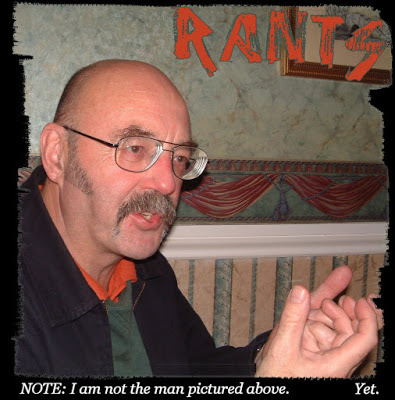 Even as cynical as I am, though, I do believe that those who’ve adopted the 2:1 frame have done so with the best of intentions. High-end programmes are now utilising some phenomenal anamorphic lenses, such as the Cooke and Angénieux lenses used for the recent season of Doctor Who, and inevitably production teams don’t want to see their painstakingly-framed and often exquisitely beautiful shots cropped for transmission in 16:9. Though I sympathise with such sentiments, I take the firm view that if something is being made primarily for viewing in a certain medium, then its format should be tailored to that medium. Those looking to paint pictures on wider canvases should make films for theatrical release instead of subverting TV.
Even as cynical as I am, though, I do believe that those who’ve adopted the 2:1 frame have done so with the best of intentions. High-end programmes are now utilising some phenomenal anamorphic lenses, such as the Cooke and Angénieux lenses used for the recent season of Doctor Who, and inevitably production teams don’t want to see their painstakingly-framed and often exquisitely beautiful shots cropped for transmission in 16:9. Though I sympathise with such sentiments, I take the firm view that if something is being made primarily for viewing in a certain medium, then its format should be tailored to that medium. Those looking to paint pictures on wider canvases should make films for theatrical release instead of subverting TV.
If TV is TV anymore, that is - I am beginning to worry that I’m proceeding from a faulty premise.
Perhaps the real question is, “Are TV programmes made primarily for viewing on TV sets, or the latest generation of 2:1 smartphones?” I know what I’d rather stare at, but I think what I’m really angry about isn’t so much the rise of 2:1 as it is the prospect of, for the first time in my life, being the dinosaur in the room.
The man in the picture (above) looms ever larger.
 The
Star Trek: Discovery
Blu-ray,
Doctor Who
,
Click & Collect
,
The ABC Murders
and just about every other major prime-time programme that I’ve watched over the last month has been missing 230,400 live pixels as their producers have embraced the chic new “cinematic” aspect ratio that’s unfriendly to even the newest 4K HDR TVs. It’s a good job my TV screen is 41.7” x 23.5” (a 50-incher when measuring from corner to corner as TV manufacturers obviously do) to start with as its watchable area is reduced to 41.7” x 20.85” with these programmes – that’s 110.5”2 of missing picture by my reckoning.
The
Star Trek: Discovery
Blu-ray,
Doctor Who
,
Click & Collect
,
The ABC Murders
and just about every other major prime-time programme that I’ve watched over the last month has been missing 230,400 live pixels as their producers have embraced the chic new “cinematic” aspect ratio that’s unfriendly to even the newest 4K HDR TVs. It’s a good job my TV screen is 41.7” x 23.5” (a 50-incher when measuring from corner to corner as TV manufacturers obviously do) to start with as its watchable area is reduced to 41.7” x 20.85” with these programmes – that’s 110.5”2 of missing picture by my reckoning. What’s most irritating of all though are the long-term implications of this. Even if the next generation of TVs base their screen dimensions on the 2:1 aspect ratio, then legacy 2:1 media is still going to appear both letterboxed and pillarboxed on their displays, as current Blu-ray standards insist upon a 1920 x 1080 frame (3840 x 2160 for UHD) and iTunes downloads (probably Amazon etc too, though I can’t speak to this) adhere to the same conventions. This means that a 2:1 image is locked into its frame between two black bars, and so if it’s ever viewed on a 2:1 screen, then the only way it could fill that screen would be if it were enlarged, resulting in a softer and incomplete picture. It’d be like it was watching a 2.35:1-letterboxed-in-4:3 VHS movie blown up on an early CRT widescreen telly - unremittingly bloody awful.
What’s most irritating of all though are the long-term implications of this. Even if the next generation of TVs base their screen dimensions on the 2:1 aspect ratio, then legacy 2:1 media is still going to appear both letterboxed and pillarboxed on their displays, as current Blu-ray standards insist upon a 1920 x 1080 frame (3840 x 2160 for UHD) and iTunes downloads (probably Amazon etc too, though I can’t speak to this) adhere to the same conventions. This means that a 2:1 image is locked into its frame between two black bars, and so if it’s ever viewed on a 2:1 screen, then the only way it could fill that screen would be if it were enlarged, resulting in a softer and incomplete picture. It’d be like it was watching a 2.35:1-letterboxed-in-4:3 VHS movie blown up on an early CRT widescreen telly - unremittingly bloody awful.
 Apologists for 2:1 argue that there is no cause for concern as most modern TVs allow for custom zooming, giving naysayers like me the option to zoom in on the letterboxed image. Whilst this is true, it does not account for the fact that zooming loses the outer edges of the image - or that it’s a right bloody faff. I have my custom zoom set to automatically blow 2.35:1 movies up to 16:9, losing the edges off the picture but filling up my screen, and I don’t begrudge this one bit as films are made - at least for now - for cinema exhibition, and I can easily flick back and forth between 16:9 and 2.35:1 almost as effortlessly as if I were watching a Christopher Nolan or Michael Bay film (in which case I don’t have to press anything at all to see the aspect ratio shift from scene to scene). However, if I alter this setting to blow a 2:1 Discovery or Who up to 16:9, I’m going to have to tweak my zoom settings every time I watch a movie. Moreover, when zooming in on a movie I’m usually blowing up an incredibly detailed UHD image, and as a result any softening of the picture is imperceptible - at least on a 50” screen situated six feet away from me. But blowing up a 720p BBC iPlayer stream yields an only slightly sharper than DVD picture, which is surely at odds with the lofty ambitions of the producers who’ve adopted 2:1. Even zooming in on the otherwise stunning 1080p Discovery Blu-ray adversely affected the image quality.
Apologists for 2:1 argue that there is no cause for concern as most modern TVs allow for custom zooming, giving naysayers like me the option to zoom in on the letterboxed image. Whilst this is true, it does not account for the fact that zooming loses the outer edges of the image - or that it’s a right bloody faff. I have my custom zoom set to automatically blow 2.35:1 movies up to 16:9, losing the edges off the picture but filling up my screen, and I don’t begrudge this one bit as films are made - at least for now - for cinema exhibition, and I can easily flick back and forth between 16:9 and 2.35:1 almost as effortlessly as if I were watching a Christopher Nolan or Michael Bay film (in which case I don’t have to press anything at all to see the aspect ratio shift from scene to scene). However, if I alter this setting to blow a 2:1 Discovery or Who up to 16:9, I’m going to have to tweak my zoom settings every time I watch a movie. Moreover, when zooming in on a movie I’m usually blowing up an incredibly detailed UHD image, and as a result any softening of the picture is imperceptible - at least on a 50” screen situated six feet away from me. But blowing up a 720p BBC iPlayer stream yields an only slightly sharper than DVD picture, which is surely at odds with the lofty ambitions of the producers who’ve adopted 2:1. Even zooming in on the otherwise stunning 1080p Discovery Blu-ray adversely affected the image quality. And that’s just legacy 2:1 media; 16:9, 2.35:1, 4:3... there is not an old programme or movie that will fit a 2:1 TV properly. The only way that we’ll get to enjoy properly proportioned, screen-filling entertainment is if we limit our viewing to new material; discard the last vestiges of physical media (which is ironic given my shift back towards it following iTunes’ refusal to allow 4K downloads); and surrender to endless, rolling subscriptions. Maybe that’s the idea.
And that’s just legacy 2:1 media; 16:9, 2.35:1, 4:3... there is not an old programme or movie that will fit a 2:1 TV properly. The only way that we’ll get to enjoy properly proportioned, screen-filling entertainment is if we limit our viewing to new material; discard the last vestiges of physical media (which is ironic given my shift back towards it following iTunes’ refusal to allow 4K downloads); and surrender to endless, rolling subscriptions. Maybe that’s the idea. Even as cynical as I am, though, I do believe that those who’ve adopted the 2:1 frame have done so with the best of intentions. High-end programmes are now utilising some phenomenal anamorphic lenses, such as the Cooke and Angénieux lenses used for the recent season of Doctor Who, and inevitably production teams don’t want to see their painstakingly-framed and often exquisitely beautiful shots cropped for transmission in 16:9. Though I sympathise with such sentiments, I take the firm view that if something is being made primarily for viewing in a certain medium, then its format should be tailored to that medium. Those looking to paint pictures on wider canvases should make films for theatrical release instead of subverting TV.
Even as cynical as I am, though, I do believe that those who’ve adopted the 2:1 frame have done so with the best of intentions. High-end programmes are now utilising some phenomenal anamorphic lenses, such as the Cooke and Angénieux lenses used for the recent season of Doctor Who, and inevitably production teams don’t want to see their painstakingly-framed and often exquisitely beautiful shots cropped for transmission in 16:9. Though I sympathise with such sentiments, I take the firm view that if something is being made primarily for viewing in a certain medium, then its format should be tailored to that medium. Those looking to paint pictures on wider canvases should make films for theatrical release instead of subverting TV.If TV is TV anymore, that is - I am beginning to worry that I’m proceeding from a faulty premise.
Perhaps the real question is, “Are TV programmes made primarily for viewing on TV sets, or the latest generation of 2:1 smartphones?” I know what I’d rather stare at, but I think what I’m really angry about isn’t so much the rise of 2:1 as it is the prospect of, for the first time in my life, being the dinosaur in the room.
The man in the picture (above) looms ever larger.
Published on December 31, 2018 15:58
December 19, 2018
TV Review | Doctor Who: “The Battle of Ranskoor Av Kolos” by Chris Chibnall
 Since it returned to our screens in 2005, each season of
Doctor Who
has ended with a bang. Their often multi-part finales would tie up all the year’s narrative threads, and sometimes more besides, while at the same time finally pitting the Doctor against a big bad whose footprints had covered the preceding eleven or twelve episodes. Each year seemed determined to outdo the last - Daleks? Pah! Daleks vs Cybermen! Daleks vs Cybermen? That’s nowt! Let’s see the Master ruling the world! How’s about a fully-fledged Dalek conquest of present-day Earth with every single modern-era companion on hand and an ersatz regeneration chucked in to captivate the media? Or the return of the Time Lords to the universe? Things had become so thrillingly and preposterously untoppable by the time that Steven Moffat took over as showrunner he had to reboot the whole damned Whoniverse to be able to start the cycle up again, only this time with even longer-running and more elaborate arcs. Chris Chibnall, however, seems intent on going his own way. But then, that’s hardly surprising from Mr Sunday Night.
Since it returned to our screens in 2005, each season of
Doctor Who
has ended with a bang. Their often multi-part finales would tie up all the year’s narrative threads, and sometimes more besides, while at the same time finally pitting the Doctor against a big bad whose footprints had covered the preceding eleven or twelve episodes. Each year seemed determined to outdo the last - Daleks? Pah! Daleks vs Cybermen! Daleks vs Cybermen? That’s nowt! Let’s see the Master ruling the world! How’s about a fully-fledged Dalek conquest of present-day Earth with every single modern-era companion on hand and an ersatz regeneration chucked in to captivate the media? Or the return of the Time Lords to the universe? Things had become so thrillingly and preposterously untoppable by the time that Steven Moffat took over as showrunner he had to reboot the whole damned Whoniverse to be able to start the cycle up again, only this time with even longer-running and more elaborate arcs. Chris Chibnall, however, seems intent on going his own way. But then, that’s hardly surprising from Mr Sunday Night.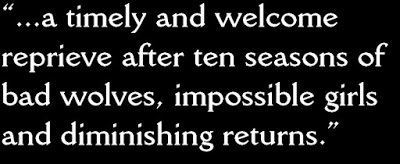 Chibnall’s approach is as commendable as it is daring. Before the season began, he promised ten episodes free from the encumbrances of pre-existing monsters and villains, and that’s exactly what he delivered. Instantly accessible wherever you jump on board, Chibnall’s Doctor Who is structured as much like the classic series as it is the new (we really need a decent retronym here; we can’t keep saying “new series” more than thirteen years post-“Rose”). To a certain extent, it doesn’t matter which order you watch these ten episodes in, provided that you start with the first two and end with the last two. It’s a timely and welcome reprieve after ten seasons of bad wolves, impossible girls and diminishing returns.
Chibnall’s approach is as commendable as it is daring. Before the season began, he promised ten episodes free from the encumbrances of pre-existing monsters and villains, and that’s exactly what he delivered. Instantly accessible wherever you jump on board, Chibnall’s Doctor Who is structured as much like the classic series as it is the new (we really need a decent retronym here; we can’t keep saying “new series” more than thirteen years post-“Rose”). To a certain extent, it doesn’t matter which order you watch these ten episodes in, provided that you start with the first two and end with the last two. It’s a timely and welcome reprieve after ten seasons of bad wolves, impossible girls and diminishing returns.The price paid for such liberty, though, is the lack of a climactic feel to this closing episode - Chibnall’s model is underwhelming by design. Whilst outwardly “The Battle of Ranskoor Av Kolos” ticks many of the necessary boxes for a season-ending script, it does so only barely, even concluding with a wrap-up speech from the Doctor that evokes the Sylvester McCoy voiceover dubbed onto the end of Survival in an attempt to engender the closure that the preceding drama hadn’t. Whilst the stakes are high enough for a season finale here, the threat to Earth feels remote and nebulous. We have guest stars the calibre of Mark Addy and Phyllis Logan, but despite expectedly marvellous performances from them, there is little that is noteworthy about Addy’s gruff space captain, and Logan’s Ux is merely a new spin on rather a tired old sci-fi trope.
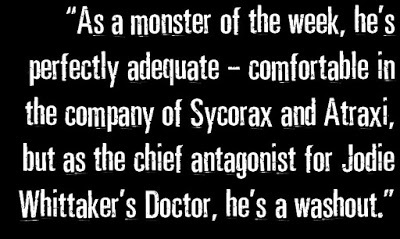 Most disappointing of all though is the season’s bookending villain, Tzim-Sha (“Tim Shaw” to you and me), the Hirogen Stenza hunter. Chibnall clearly flourishes telling stories about people, not monsters, and so naturally the new Doctor’s first big bad had to be an individual rather than a group or even an entire species. The trouble is that Tzim-Sha is by no means as well-drawn or alluring as any member of Team: TARDIS. As a monster of the week, he’s perfectly adequate - comfortable in the company of Sycorax and Atraxi, but as the chief antagonist for Jodie Whittaker’s dazzling Doctor, he’s a washout. Even (much) older and sporting a Darth Vader-like iron lung (at least when it suits the drama), embittered old Tim’s only real ‘virtue’ is his history with Graham, which allows Bradley Walsh to deliver one final, emotional performance to complete his character’s poignant and rousing arc. It’s here that “The Battle of Ranskoor Av Kolos” delivers.
Most disappointing of all though is the season’s bookending villain, Tzim-Sha (“Tim Shaw” to you and me), the Hirogen Stenza hunter. Chibnall clearly flourishes telling stories about people, not monsters, and so naturally the new Doctor’s first big bad had to be an individual rather than a group or even an entire species. The trouble is that Tzim-Sha is by no means as well-drawn or alluring as any member of Team: TARDIS. As a monster of the week, he’s perfectly adequate - comfortable in the company of Sycorax and Atraxi, but as the chief antagonist for Jodie Whittaker’s dazzling Doctor, he’s a washout. Even (much) older and sporting a Darth Vader-like iron lung (at least when it suits the drama), embittered old Tim’s only real ‘virtue’ is his history with Graham, which allows Bradley Walsh to deliver one final, emotional performance to complete his character’s poignant and rousing arc. It’s here that “The Battle of Ranskoor Av Kolos” delivers.Perhaps more successfully than any other in the history of the show, even the unforgettable 1963/64 run that kick-started it all, this season has introduced us to a TARDIS full of folk that it’s difficult not to care deeply about. The Doctor’s three friends are all down-to-Earth, relatable sorts, yet each is distinct with his or her own clear story arcs – arcs that “The Battle of Ranskoor Av Kolos” concludes rather beautifully. For the bereaved boys, events come full circle, forcing Graham down a path that Ryan won’t follow him down. Their thread of plot feels tense, volatile and thoroughly rewarding, and it delivers the sort of punchline that only Doctor Who really can. It’s just as delightful to see Mandip Gill's PC Khan complete her transformation from Judy Hopps to poised interstellar adventurer, particularly as her development has largely mirrored the new Doctor’s. The self-assurance that seems to have eluded the titular Time Lord’s first female incarnation until very recently is now manifest; it’s as if, like Yaz, she’s finally learned to trust in herself and her judgements. Or maybe it’s just that I, as a viewer, have, and I’m just projecting. Either way, it works magnificently.
That being said, it’s now clear that Thirteen lacks the gravitas of most of the male Doctors, particularly Sylvester McCoy and those that we’ve been blessed with since 2005. If we haven't seen it by now, I doubt that we’re ever going to - she is who she is. This isn’t automatically a bad thing - just another distinction to set her apart from her predecessors and further the reinvigoration of the series. Quite ironically, given his comments about the Doctor’s sex change, Whittaker’s Doctor seems to be most similar in nature to Peter Davison’s fifth Doctor, who survived his misadventures on “feckless charm” and wit as opposed to the fire and steel of later iterations.
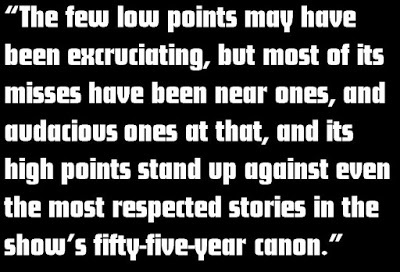 Even so, I was hoping, even sort of expecting, that by this point I would have fully accepted the notion of the transgender Time Lord, but the reality is that my once-trenchant views have simply become... less so. The only real difference between my opinions today and those I held three months ago is that now, being quite taken with Thirteen, I want to like the idea. (Quite literally) nine times out of ten, the Doctor’s change of gender hasn’t affected my enjoyment of the programme at all; Whittaker’s been so very extraordinary that I’ve been bowled over by her performances and thought of little else. The sting only comes when I revisit an earlier Doctor, as I’m currently doing with my David Tennant-mad eldest daughter, and the analytical fanboy in me can’t reconcile his long-held notion that the Doctor has always been the same man with the reality that ‘a Doctor Who’ can be whatever the BBC decide they need it to be depending on the politics of the moment. Time Lords, especially the Doctor, changing their sex just doesn’t concur with everything that I’d always understood about them; it doesn’t fit my rule. Yes, the Doctor was never a Hollywood dick-swinging character, but as my current revisitations are reminding me, he loved Rose. He got himself a wife. Once upon a time he even had a family. As a bloke, you could put yourself in his Converse. Now, you have to try bloody hard to stop yourself falling in love with your brilliant idol suddenly rendered woman. All I can do is try not to ruminate on it, because when I’m watching the show, I’m enjoying it so much that the issue scarcely enters my head. And, ultimately, that’s the only time that it would ever matter.
Even so, I was hoping, even sort of expecting, that by this point I would have fully accepted the notion of the transgender Time Lord, but the reality is that my once-trenchant views have simply become... less so. The only real difference between my opinions today and those I held three months ago is that now, being quite taken with Thirteen, I want to like the idea. (Quite literally) nine times out of ten, the Doctor’s change of gender hasn’t affected my enjoyment of the programme at all; Whittaker’s been so very extraordinary that I’ve been bowled over by her performances and thought of little else. The sting only comes when I revisit an earlier Doctor, as I’m currently doing with my David Tennant-mad eldest daughter, and the analytical fanboy in me can’t reconcile his long-held notion that the Doctor has always been the same man with the reality that ‘a Doctor Who’ can be whatever the BBC decide they need it to be depending on the politics of the moment. Time Lords, especially the Doctor, changing their sex just doesn’t concur with everything that I’d always understood about them; it doesn’t fit my rule. Yes, the Doctor was never a Hollywood dick-swinging character, but as my current revisitations are reminding me, he loved Rose. He got himself a wife. Once upon a time he even had a family. As a bloke, you could put yourself in his Converse. Now, you have to try bloody hard to stop yourself falling in love with your brilliant idol suddenly rendered woman. All I can do is try not to ruminate on it, because when I’m watching the show, I’m enjoying it so much that the issue scarcely enters my head. And, ultimately, that’s the only time that it would ever matter.And so Doctor Who’s finest season since Matt Smith’s first, if not David Tennant’s last, ends on an emotionally rewarding but somewhat subdued note, with an episode that, for better or worse, encapsulates all of the season’s pros and cons. This season’s few low points may have been excruciating, but most of its misses have been near ones, and audacious ones at that, and its high points stand up against even the most respected stories in the show’s fifty-five-year canon. “Rosa”, “Demons of the Punjab” and “Kerblam!” could hold their own against any story that you could pluck from the golden eras of Russell T Davies; Barry Letts and Terrance Dicks; even the unassailable Philip Hinchcliffe and Robert Holmes.
Sadly the series’ traditional Christmas special will now follow Saturday nights, pre-title sequences and 230,400 pixels into the abyss. Particularly with no new Star Wars movie to fall back on, it’ll be lonely this Christmas, though with a title like “Resolution”, there is every chance that the series’ first New Year’s Day special since The End of Time might just provide us with the fireworks that “The Battle of Ranskoor Av Kolos” was missing...
Doctor Who will return to BBC One for a one-off special on 1st January 2019. This episode is available to stream or download on BBC iPlayer in the UK, where the preceding 155 episodes are also currently available. A series pass is available from iTunes for £23.99.
Published on December 19, 2018 13:16
December 6, 2018
TV Review | Doctor Who: “It Takes You Away” by Ed Hime
 Ed Hime’s first script for
Doctor Who
has managed to do something that only a few episodes in a thousand have ever managed to: divide opinion... within me. “It Takes You Away” is spooky, surreal and unsettling - yet at times laugh-out-loud funny. Silly and sinister, difficult to grade or quantify, this one is very much this season’s “Midnight”.
Ed Hime’s first script for
Doctor Who
has managed to do something that only a few episodes in a thousand have ever managed to: divide opinion... within me. “It Takes You Away” is spooky, surreal and unsettling - yet at times laugh-out-loud funny. Silly and sinister, difficult to grade or quantify, this one is very much this season’s “Midnight”.
Beautifully shot by veteran series director Jamie Childs, the episode’s picturesque Norwegian setting continues this year’s trend of (quite literally) breaking new ground for the show, the isolated Scandinavian cabin joining the likes of Sheffield high rises and the freshly-forged India/Pakistan border on Chris Chibnall’s long list of fresh locales. But the location here is every bit as haunting as it is beautiful, even in the bright light of day which, if anything, only seems to add to the crippling tension. This story’s “monster” doesn’t need to wait for darkness to fall to take you away.
 Similar could be said of Jodie Whittaker’s Doctor, who, for the first time in her reign, seems to completely own the situation from the outset. Indeed, her command of proceedings here is comparable to her four immediate predecessors’ default settings, as it were, which is especially important after last week’s much meeker interpretation. Hime has her acting quickly and decisively, even unravelling the mystery of - and agreeing terms with - the Solitract despite hardly breaking a sweat.
Similar could be said of Jodie Whittaker’s Doctor, who, for the first time in her reign, seems to completely own the situation from the outset. Indeed, her command of proceedings here is comparable to her four immediate predecessors’ default settings, as it were, which is especially important after last week’s much meeker interpretation. Hime has her acting quickly and decisively, even unravelling the mystery of - and agreeing terms with - the Solitract despite hardly breaking a sweat.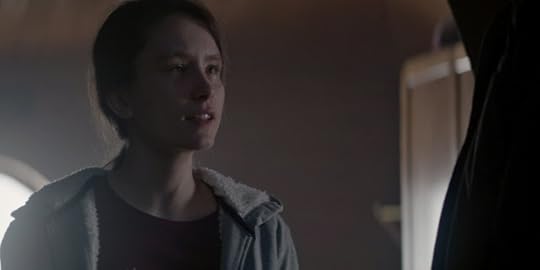
 “It Takes You Away” is marked by some particularly arresting performances, young guest star Eleanor Wallwork’s chief amongst them. Apparently abandoned by her father to the mercies of a ravenous monster, the blind teenage character is brought to life with striking realism by Wallwork. An already well-written part is knocked out of the park as her initial terror recedes and her grief-fuelled teenage angst and misplaced aggression come to the fore. Tosin Cole deserves a lot of credit too for being such a great foil to her - “It Takes You Away” might be Ryan’s strongest outing yet, casting him in a pseudo-paternal role that achieves everything “The Tsuranga Conundrum” so spectacularly failed to.
“It Takes You Away” is marked by some particularly arresting performances, young guest star Eleanor Wallwork’s chief amongst them. Apparently abandoned by her father to the mercies of a ravenous monster, the blind teenage character is brought to life with striking realism by Wallwork. An already well-written part is knocked out of the park as her initial terror recedes and her grief-fuelled teenage angst and misplaced aggression come to the fore. Tosin Cole deserves a lot of credit too for being such a great foil to her - “It Takes You Away” might be Ryan’s strongest outing yet, casting him in a pseudo-paternal role that achieves everything “The Tsuranga Conundrum” so spectacularly failed to.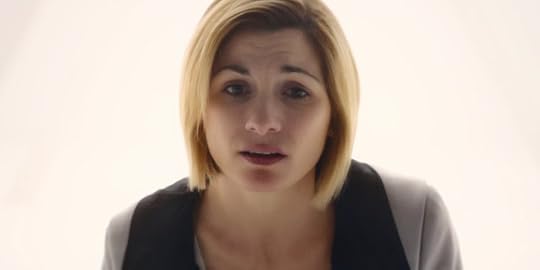
Inevitably, though, a story built on remorse was always going dominated by Bradley Walsh's recently bereaved Graham. The temptation that he faces here might be the only thing in the episode not to smack of originality, but it’s undoubtedly its emotional high point, and its coda with Ryan would not have been out of place in next week’s finale, such is its resonance. Walsh is, once more, exceptional.
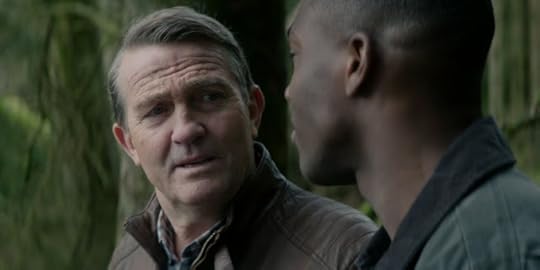 Flesh-eating moths, echoes of monsters, a woolly rebellion and a lonely and sentient universe in exile - “It Takes You Away” certainly delivers on the promise of its title, whisking its viewers away to an Anti-Zone where any conventions of tone or consistency are forsaken in favour of a high-concept antagonist, an antagonising protagonist and humour so silly that it makes farting Raxacoricofallapatorian seem high-brow.
Flesh-eating moths, echoes of monsters, a woolly rebellion and a lonely and sentient universe in exile - “It Takes You Away” certainly delivers on the promise of its title, whisking its viewers away to an Anti-Zone where any conventions of tone or consistency are forsaken in favour of a high-concept antagonist, an antagonising protagonist and humour so silly that it makes farting Raxacoricofallapatorian seem high-brow. The new series of Doctor Who airs on Sunday nights on BBC One and is available to stream or download on BBC iPlayer in the UK, where the preceding 154 episodes are also currently available. A series pass is available from iTunes for £23.99.
Published on December 06, 2018 15:06
December 2, 2018
Graphic Novel Review | Star Wars: Darth Vader - Dark Lord of the Sith #1 - #6 by Charles Soule and Giuseppe Camuncoli
 I’ve recently reconnected with a very old friend who’s keen to extol the merits of Marvel comics despite my mounting obsession with the DC Universe. I think he expected me to take up him up on his kind offer to loan me some of the much-loved X-Men titles gathering dust in his garage, but instead, to what I’m sure is a mix of both indignation and intrigue on his part, I’ve started down a very different path with Marvel, picking up the first volume of Charles Soule’s (Daredevil, The Death of Wolverine) highly-regarded Star Wars: Darth Vader - Dark Lord of the Sith strip which collects together the first six issues of the run (all six instalments of “The Chosen One”), under the – potentially confusing – umbrella title Imperial Machine.
I’ve recently reconnected with a very old friend who’s keen to extol the merits of Marvel comics despite my mounting obsession with the DC Universe. I think he expected me to take up him up on his kind offer to loan me some of the much-loved X-Men titles gathering dust in his garage, but instead, to what I’m sure is a mix of both indignation and intrigue on his part, I’ve started down a very different path with Marvel, picking up the first volume of Charles Soule’s (Daredevil, The Death of Wolverine) highly-regarded Star Wars: Darth Vader - Dark Lord of the Sith strip which collects together the first six issues of the run (all six instalments of “The Chosen One”), under the – potentially confusing – umbrella title Imperial Machine.Soule’s Dark Lord of the Sith series is very much in the public eye presently, given the upcoming release of its potentially contentious final issue on 19th December. Not to be confused with Kieron Gillen’s earlier run, which takes place after Soule’s series in the new Disney canon, Dark Lord of the Sith actually begins before Star Wars: Episode III – Revenge of the Sith has even concluded, with (at least) this opening six-issue story taking place between the often-lambasted, “Noooooooo!” Vader wake-up scene and the Sith apprentice’s more composed, more imperious, presence on the bridge of a Star Destroyer alongside Palpatine and Tarkin nearer the end. It’s a critical chapter in the story of the Dark Lord, and as such, one that’s been told before, most notably in James Luceno’s frustrating but insightful 2005 novel, Dark Lord – The Rise of Darth Vader , which “The Chosen One”, and no doubt Soule’s subsequent stories in the series, will now overwrite.

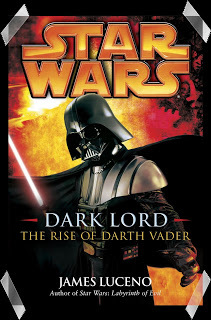 Despite both stories sharing the same goal, and even walking a very similar path, “The Chosen One” succeeds in almost every area that Dark Lord failed – but unfortunately the reverse is also true. In Luceno’s book, the eponymous Sith Lord is absent from the narrative for great swathes of the action, but when he does appear we are privy to every aspect of his inner turmoil and physical agony. Luceno devotes considerable chunks of prose to Vader’s gradual acceptance of his mechanical limbs and life-support suit; he even delves into the Dark Lord’s built-in colostomy bags and details the daily, painful skin-scrapings that he must endure. Yet Luceno’s novel lacks anything even approaching shock or spectacle – something that “The Chosen One” delivers relentlessly. It does so, however, at the expense of finesse, and so at times it proves to be just as maddening a read as Luceno’s Dark Lord.
Despite both stories sharing the same goal, and even walking a very similar path, “The Chosen One” succeeds in almost every area that Dark Lord failed – but unfortunately the reverse is also true. In Luceno’s book, the eponymous Sith Lord is absent from the narrative for great swathes of the action, but when he does appear we are privy to every aspect of his inner turmoil and physical agony. Luceno devotes considerable chunks of prose to Vader’s gradual acceptance of his mechanical limbs and life-support suit; he even delves into the Dark Lord’s built-in colostomy bags and details the daily, painful skin-scrapings that he must endure. Yet Luceno’s novel lacks anything even approaching shock or spectacle – something that “The Chosen One” delivers relentlessly. It does so, however, at the expense of finesse, and so at times it proves to be just as maddening a read as Luceno’s Dark Lord.
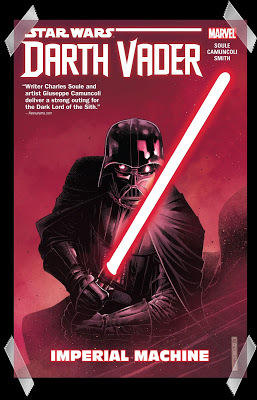 Buoyed by the jaw-dropping, cinematic artwork of Giuseppe Camuncoli (Hellblazer, The Amazing Spider-Man), “The Chosen One” proves instantly irresistible. Its receding opening crawl effortlessly sucks the reader back into that galaxy far, far away where they see a recognisable scene playing out... with a twist. Here, on that stormy Coruscant night in Palpatine’s medical tower, Vader doesn’t limit his wrath to medical bots. As the famous scene continues beyond the film’s curtain-close transition, he uses the Force to throw his master right out of the panel – an act that would surely have earned any other man an on-the-spot death sentence. Darth Sidious strikes back, of course, and in so doing makes his apprentice’s first assignment all the more pressing: the construction of a Sith lightsaber. Vader must carry out his mission alone, and without a ship. He’ll have to take on Imperial Forces, and he’ll have to find a living Jedi whose lightsaber’s crystal he’ll need to “make bleed”. And he’ll have to do it all whilst acclimatising to a suit that’s seemingly unable to tackle rough terrain without one of its legs breaking off.
Buoyed by the jaw-dropping, cinematic artwork of Giuseppe Camuncoli (Hellblazer, The Amazing Spider-Man), “The Chosen One” proves instantly irresistible. Its receding opening crawl effortlessly sucks the reader back into that galaxy far, far away where they see a recognisable scene playing out... with a twist. Here, on that stormy Coruscant night in Palpatine’s medical tower, Vader doesn’t limit his wrath to medical bots. As the famous scene continues beyond the film’s curtain-close transition, he uses the Force to throw his master right out of the panel – an act that would surely have earned any other man an on-the-spot death sentence. Darth Sidious strikes back, of course, and in so doing makes his apprentice’s first assignment all the more pressing: the construction of a Sith lightsaber. Vader must carry out his mission alone, and without a ship. He’ll have to take on Imperial Forces, and he’ll have to find a living Jedi whose lightsaber’s crystal he’ll need to “make bleed”. And he’ll have to do it all whilst acclimatising to a suit that’s seemingly unable to tackle rough terrain without one of its legs breaking off.It’s an arresting, urgent start to the story; one that puts an exciting new spin on the Vader/Sidious relationship whilst expanding upon Sith mythology in a fascinating way. Where it falls down, ironically, is in its breakneck pace – a trait that Dark Lord sorely lacked. Events move so quickly that the reader doesn’t have the chance to process them, never mind Darth Vader himself. In one panel he’s bringing the whole might of the dark side down on his master as he rages against the death of the woman who meant everything to him – the woman that he burnt down the Jedi Order, and indeed the Republic at large, to save – and six panels later he’s chosen life. And that’s not me arbitrarily bludgeoning in a Trainspotting reference just to plug my old Irvine Welsh reviews; he literally, explicitly choses to live without Soule us offering any real clue as to his motives.

The remainder of the story lives and dies in the same vein. Vader’s Jedi hunt is the stuff of many a fan’s fantasy, and the fact that he’s battling Imperial forces with a green lightsaber for half of it only serves to make it all the more illicit and alluring. The trouble is, we don’t know what’s going on in Vader’s head. Even when he has a droid to talk to, his dialogue is purely procedural, and when he has someone to fight, any lines the calibre of, “When I left you, I was but the learner...”, or even the pithy-but-powerful, “Impressive. Most impressive,” are eschewed in favour of utterances like “Hssssssk!” and “Nnnngh!”, which I don’t recall existing in James Earl Jones’ goosebump-raising repertoire.
 The key attribute that “The Chosen One” shares with Dark Lord is the notion that Vader is, as you might expect, really rather feeble at this time in his life. The guy’s just been burned alive and lost his remaining three limbs, not to mention the ability to breathe unaided. Even when pit against weaker opponents on paper, he’s hopelessly outmatched, as Luceno explores through prose and Soule and Camuncoli depict pictorially. Both interpretations see Vader gradually develop both his suit and his mastery of it, so that by the stories’ end his is on the cusp of becoming the seemingly invincible enforcer of the first
Star Wars
trilogy, but there is one key difference in his journey between them: the role played by Emperor Palpatine in his transaction from crippled Jedi traitor to eponymous Imperial machine.
The key attribute that “The Chosen One” shares with Dark Lord is the notion that Vader is, as you might expect, really rather feeble at this time in his life. The guy’s just been burned alive and lost his remaining three limbs, not to mention the ability to breathe unaided. Even when pit against weaker opponents on paper, he’s hopelessly outmatched, as Luceno explores through prose and Soule and Camuncoli depict pictorially. Both interpretations see Vader gradually develop both his suit and his mastery of it, so that by the stories’ end his is on the cusp of becoming the seemingly invincible enforcer of the first
Star Wars
trilogy, but there is one key difference in his journey between them: the role played by Emperor Palpatine in his transaction from crippled Jedi traitor to eponymous Imperial machine.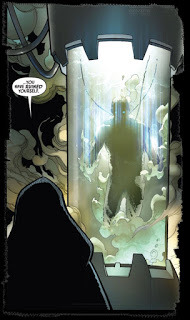 Luceno’s novel depicts Sidious as an almost fatherly figure to Vader, continuing along the Anakin / Palpatine trajectory as if they hadn’t just conquered the galaxy together to perpetuate an evil sect. When Vader looks up at his master through burned, hollow eyes and asks, “Are these the faces of victory?” in Dark Lord, he receives a surprisingly stirring pep talk from his master that could just have easily come out of Yoda’s mouth. In “The Chosen One”, much more logically, Sidious drops this fatherly façade, abusing and belittling his apprentice at every turn. He shocks him with lightening. He maroons him without weapons on a barren world. He scoffs at him as he bathes naked and limbless in a bacta tank, ridiculing his ruin. As such, the progress that Vader makes in “The Chosen One” is all of his own making, and it’s all the more potent for it.
Luceno’s novel depicts Sidious as an almost fatherly figure to Vader, continuing along the Anakin / Palpatine trajectory as if they hadn’t just conquered the galaxy together to perpetuate an evil sect. When Vader looks up at his master through burned, hollow eyes and asks, “Are these the faces of victory?” in Dark Lord, he receives a surprisingly stirring pep talk from his master that could just have easily come out of Yoda’s mouth. In “The Chosen One”, much more logically, Sidious drops this fatherly façade, abusing and belittling his apprentice at every turn. He shocks him with lightening. He maroons him without weapons on a barren world. He scoffs at him as he bathes naked and limbless in a bacta tank, ridiculing his ruin. As such, the progress that Vader makes in “The Chosen One” is all of his own making, and it’s all the more potent for it.And as Soule and Camuncoli’s assault on the eyeballs reaches its crescendo, it finally offers us a fleeting glimpse into Vader’s fragmented psyche. Having retrieved a kyber crystal from the blade of a Jedi that he’s defeated, Vader pours every ounce of his angst into it in an attempt to make it bleed red. And he fails.

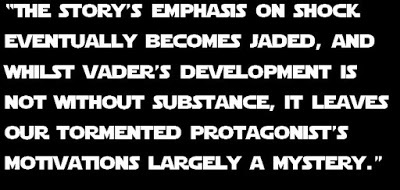 The next thing we see is Vader marching into Emperor Palpatine’s office, green blade in hand, the wreck of his armour revealing an exposed eye gleaming with murderous intent. Within the space of a few spectacular panels, the broken body of Darth Sidious is lying on the ground and Vader is walking away triumphant. When we next see Vader, helmet in hand and prostrate, he’s begging Obi-Wan Kenobi to end him, and if there had been any doubt it’s now crystal clear that the mystical act of bleeding the kyber crystal is forcing Vader to confront the part of Anakin Skywalker that still exists within him. He must either surrender to it or bury the former Jedi’s impulses for good, and of course we all know how that story ends.
The next thing we see is Vader marching into Emperor Palpatine’s office, green blade in hand, the wreck of his armour revealing an exposed eye gleaming with murderous intent. Within the space of a few spectacular panels, the broken body of Darth Sidious is lying on the ground and Vader is walking away triumphant. When we next see Vader, helmet in hand and prostrate, he’s begging Obi-Wan Kenobi to end him, and if there had been any doubt it’s now crystal clear that the mystical act of bleeding the kyber crystal is forcing Vader to confront the part of Anakin Skywalker that still exists within him. He must either surrender to it or bury the former Jedi’s impulses for good, and of course we all know how that story ends.
Were “The Chosen One” a Doctor Who story, it would probably be labelled ‘fanwank’, because it delivers pretty much everything a fan could possibly want from it, but often at the expense of plot or character. The story’s emphasis on shock eventually becomes jaded, and whilst Vader’s development is not without substance, in the absence of any meaningful dialogue or thought boxes it leaves our tormented protagonist’s motivations largely a mystery. Yet the sheer visceral force of Camuncoli’s artwork, coupled with Soule’s inspired reimagining of the Sidious/Vader relationship, ultimately gives these six issues the edge on the novel that they’ve ousted. Indeed, Star Wars seems innately suited to the comic-book medium, and if this series can demonstrate just a little bit more logic and transparency, I can see how it could have developed into the all-conquering juggernaut that it’s now purported to be.
 Star Wars: Darth Vader - Dark Lord of the Sith: Imperial Machine is available to download for £8.49 from the
iTunes Store
or £7.49 from
Amazon’s Kindle Store
. A trade paperback is available to order from
Amazon
for twice the price. Alternatively, Star Wars: Dark Lord - The Rise of Darth Vader is available to download for £4.99 from the iTunes Store and Amazon's Kindle Store. A paperback is available to order from Amazon for £8.39 plus delivery.
Star Wars: Darth Vader - Dark Lord of the Sith: Imperial Machine is available to download for £8.49 from the
iTunes Store
or £7.49 from
Amazon’s Kindle Store
. A trade paperback is available to order from
Amazon
for twice the price. Alternatively, Star Wars: Dark Lord - The Rise of Darth Vader is available to download for £4.99 from the iTunes Store and Amazon's Kindle Store. A paperback is available to order from Amazon for £8.39 plus delivery.
Published on December 02, 2018 06:43
November 28, 2018
TV Review | Doctor Who: “The Witchfinders” by Joy Wilkinson
 It says a lot about the quality of Chris Chibnall’s first season in charge of
Doctor Who
that “The Witchfinders”, which is more compelling than much of what aired in the dying days of the Moffat era, left me feeling disappointed and underwhelmed.
It says a lot about the quality of Chris Chibnall’s first season in charge of
Doctor Who
that “The Witchfinders”, which is more compelling than much of what aired in the dying days of the Moffat era, left me feeling disappointed and underwhelmed.
As a once-avid consumer of Doctor Who across the media, particularly in its wilderness years off the air, I was always going to be inclined to compare a Doctor vs witchsmeller pursuivant story unfavourably to Steve Lyons’ twenty-year-old Salem novel, The Witch Hunters , which, if you love the show enough to be reading my musings on it, you’ll almost certainly enjoy. It’s an excruciating and brilliant read that showcases the sort of grit and nuance that, ironically, has set this season’s finest offerings apart from the pack. Yet Joy Wilkinson’s first script for the series borders on the prosaic. It’s Doctor Who painted by numbers, perfectly entertaining, but forgettable and flat - save for when it’s memorable for all the wrong reasons.
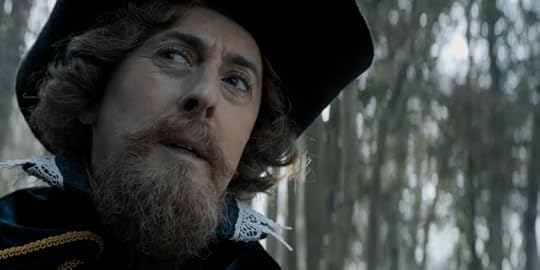
The realisation of King James I, for instance, is painful. Be it due to Alan Cumming’s performance, Wilkinson’s writing, or a combination of both, the monarch comes across as CBeebies-hammy; at times it’s like watching Gigglebiz. Fortunately Siobhan Finneran (Benidorm, Downton Abbey) and particularly young Tilly Steele (Victoria) are haunting and credible in their supporting roles, but unfortunately their portrayals do not sit well with the king’s camp theatrics.

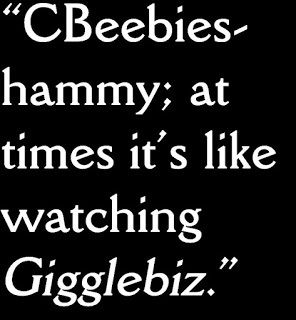 The regulars, as ever, all give solid performances. Ryan, the king’s “Nubian prince”, handles the script’s comedic elements artfully, as does Bradley Walsh, though I was less than impressed with the subject matter of his. This episode’s heavy focus on the Doctor having to play assistant to Graham because of her gender brought back that unsettling disconnect for me. I love Thirteen, and think Jodie Whittaker is incredible in the role, but at times I still find it hard to reconcile her incarnation with the Doctor’s preceding thirteen. Little moments, such as the one I highlighted in “Demons of the Punjab”, work splendidly in recognising the character’s newfound womanhood, even managing to feel Doctorish in the process, but this episode’s approach, whilst arguably historically warranted, is more akin to using a sledgehammer than a sonic. What’s particularly irritating is that the Doctor just grins and bears the rampant sexism of the age - I would at least expect Thirteen to deliver her usual, uncomfortable parting riposte to her would-be oppressors as she beats a gauche retreat.
The regulars, as ever, all give solid performances. Ryan, the king’s “Nubian prince”, handles the script’s comedic elements artfully, as does Bradley Walsh, though I was less than impressed with the subject matter of his. This episode’s heavy focus on the Doctor having to play assistant to Graham because of her gender brought back that unsettling disconnect for me. I love Thirteen, and think Jodie Whittaker is incredible in the role, but at times I still find it hard to reconcile her incarnation with the Doctor’s preceding thirteen. Little moments, such as the one I highlighted in “Demons of the Punjab”, work splendidly in recognising the character’s newfound womanhood, even managing to feel Doctorish in the process, but this episode’s approach, whilst arguably historically warranted, is more akin to using a sledgehammer than a sonic. What’s particularly irritating is that the Doctor just grins and bears the rampant sexism of the age - I would at least expect Thirteen to deliver her usual, uncomfortable parting riposte to her would-be oppressors as she beats a gauche retreat.
And so whilst “The Witchfinders” is far from being the calamity that “The Tsuranga Conundrum” was, it still failed to capture me. This season has been so fresh and so innovative that an episode reliant on a traditional alien monster masquerading as a witch and hidden within a witch-burning landowner feels a bit... meh.
The new series of Doctor Who airs on Sunday nights on BBC One and is available to stream or download on BBC iPlayer in the UK, where the preceding 153 episodes are also currently available. A series pass is available from iTunes for £23.99.
The Witch Hunters by Steve Lyons is available to download for just £1.99 from either the iTunes Store or Amazon’s Kindle Store.
Published on November 28, 2018 09:12
November 22, 2018
TV Review | Doctor Who: “Kerblam!” by Pete McTighe
 Another week, another newcomer, another timely and politically-charged script.
Doctor Who
’s back and it’s on fire.
Another week, another newcomer, another timely and politically-charged script.
Doctor Who
’s back and it’s on fire. Pete McTighe’s “Kerblam!” packs all the punch of its title, and more besides, as it satirises the future according to Amazon and takes the viewer through just about emotion in the screenwriters’ playbook. “Kerblam!” wears its humour and its hazard on its sleeve, but its onomatopoeic handle is particularly apposite when it pulls the rug out from beneath viewers with its frequent twists and misdirections, or smashes them over the head with its sudden pathos. Kerblam!
Pete McTighe’s “Kerblam!” packs all the punch of its title, and more besides, as it satirises the future according to Amazon and takes the viewer through just about emotion in the screenwriters’ playbook. “Kerblam!” wears its humour and its hazard on its sleeve, but its onomatopoeic handle is particularly apposite when it pulls the rug out from beneath viewers with its frequent twists and misdirections, or smashes them over the head with its sudden pathos. Kerblam! “You’re just making sounds now...”
“You’re just making sounds now...”The episode’s subject matter is particularly unsettling as we approach Black Friday and our annual online orders supernova; it’s a triumph of scheduling, as well as everything else. Parts of the story put me very much in mind of this year’s supremely disquieting X-Files episode “Rm9sbG93ZXJz”, which played upon the same sort of fears, but of course here McTighe’s story has a much more nuanced and ambiguous punchline than Shannon Hamblin and Kristen Cloke’s did. Indeed, “Kerblam!” is television at its most thoughtful disguised as television at its most crude, its well-observed script stirring up classic corporate techno-fear with its left hand while its right reminds us of the real root of all evil (which is a recurring theme for this year, it seems).

Even in a season populated by such revered actors, the cast of “Kerblam!” still manages to stand out. Household names like Jodie Whittaker’s fellow Broadchurch alumnae, Julie Hesmondhalgh, and comedian Lee Mack certainly deliver performances worthy of their repute, although for me it was the two youngsters who really shone. Claudia Jessie imbues her down-at-heel but eternally optimistic character, Kira, with a spirit so inspiring that when the Doctor comments upon it, she’s only giving voice to what the audience is already thinking. Meanwhile, Kira’s would-be suitor, Leo Flanagan’s bog-cleaning Charlie Duffy, gives a convincing and layered performance that on occasion threatens to steal the whole show.
 Above: In defence of the 2:1 - the four members of Team: TARDIS really need the trendy super-wide aspect ratio if they want to have a chance of sharing a shot together.
Above: In defence of the 2:1 - the four members of Team: TARDIS really need the trendy super-wide aspect ratio if they want to have a chance of sharing a shot together.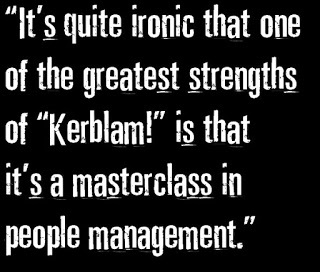 McTighe’s incredibly adroit storytelling also does a terrific job of serving all four members of Team: TARDIS in equal measure, which is quite a feat given the size of the gang, and doubly so when you consider the time afforded to the supporting players. Whittaker’s Doctor mercurially leads the charge, while the rest of her gang pursue their respective avenues of investigation. Yaz is paired with Mack’s memorable everyman, Dan Cooper, and once again serves as the episode’s heart, while Graham takes on janitorial duties with Charlie (and thus the critical exposition). Ryan, meanwhile, enjoys his strongest outing since “Rosa”, as the story’s warehouse setting and physical challenges force him to address both his feelings about his vocation and his dyspraxia head-on. It’s quite ironic that one of the greatest strengths of “Kerblam!” is that it’s a masterclass in people management.
McTighe’s incredibly adroit storytelling also does a terrific job of serving all four members of Team: TARDIS in equal measure, which is quite a feat given the size of the gang, and doubly so when you consider the time afforded to the supporting players. Whittaker’s Doctor mercurially leads the charge, while the rest of her gang pursue their respective avenues of investigation. Yaz is paired with Mack’s memorable everyman, Dan Cooper, and once again serves as the episode’s heart, while Graham takes on janitorial duties with Charlie (and thus the critical exposition). Ryan, meanwhile, enjoys his strongest outing since “Rosa”, as the story’s warehouse setting and physical challenges force him to address both his feelings about his vocation and his dyspraxia head-on. It’s quite ironic that one of the greatest strengths of “Kerblam!” is that it’s a masterclass in people management.
I’m also incredibly taken with the episode’s look, which to the production team’s credit favours authenticity over spectacle - at least for the most part. Warehouses will always have a certain functional aesthetic, I reckon, and much the same probably applies to clean and light corporate lobbies too. When the design does need to appear more technologically advanced, though, “Kerblam!” convinces effortlessly, with its trademark Kerb!am Men and their ‘TeamMates’ straddling that fine line between retro-chic company poster boys and convincing future tech.

Best of all, though, “Kerblam!” has the one essential ingredient that sets the most memorable Doctor Who stories apart from the good but largely forgotten ones – and in this case, it’s bubble wrap. Taking the mundane and infusing it with menace has been a signature of the series over the years, and McTighe has arguably taken the concept to another level here with his pliable plastic packing material that goes... KERBLAM!
The new series of Doctor Who airs on Sunday nights on BBC One and is available to stream or download on BBC iPlayer in the UK, where the preceding 152 episodes are also currently available. A series pass is available from iTunes for £23.99.
Published on November 22, 2018 04:14
November 13, 2018
TV Review | Doctor Who: “Demons of the Punjab” by Vinay Patel
The first
Doctor Who
episode of 2018 not to feature showrunner Chris Chibnall’s name anywhere on the byline is Vinay Patel’s “Demons of the Punjab”, a superlative fifty minutes of telly even by this season’s usual standards.
By turns thrilling and moving, Patel’s story explores an event in history previously untouched by the show, and it does so through the most intimate of lenses. As the UK stands on the precipice of Brexit, Doctor Who whisks its viewers back in time to the partition of India, reflecting on old divisions as a young Muslim woman and Hindu prepare to wed on the very spot that their nations are to be divided. That young Muslim woman is Yaz’s grandmother. But that young Hindu man ain’t her grandfather...
In some ways reminiscent of Paul Cornell’s seminal “Father’s Day”, yet in others almost its antithesis, “Demons of the Punjab” benefits from that crushing sense of inevitability that the best historical adventures have, only here it’s turned up to eleven - Yaz’s very existence is a constant reminder of the tragedy to come. The drama is borne not out of the Doctor and her friends trying to save the world, but simply unravel the mysteries of it.
The mystery of the piece unfolds very deliberately and delightfully, and as it does, it forces viewers to take a hard look at their preconceptions when it comes to aliens - in all senses of the word. In particular, I really have to applaud Patel’s imagination - and gall - when it comes to the execution of his eponymous “Demons”. Terrifying, mesmerising, perfect creations... who turn the narrative on its head when they reveal their true purpose, and mystery turns to shock and sadness. It’s another fresh angle in a season of fresh angles; another wrinkle in the reinvention that makes Doctor Who shine like new.
Mandip Gill, as you might expect, really carries this episode. The script is a gift for her character, and her performance ekes every ounce of excellence out of it. Yet this episode is perhaps more notable for Jodie Whittaker’s dazzling turn - I’m rapidly falling in love with Thirteen, and “Demons of the Punjab” is a fifty-minute embodiment of why. I have absolutely no doubt now that she’s the same Doctor that he’s always been - here she’s incredibly forceful, arguably for the first time, yet she also gets to partake in a hen do and be - dare I say it - a little bit girly... but in what feels like an authentically ‘Doctorish’ way. It actually made me realise how little the character has changed since Matt Smith’s “just us girls...” conspiratorial interpretation. Thirteen is a vibrant force throughout whole episode - a thrilling splash of colour in a muted world of ubiquitous green and brown.
Inevitably, the Doctor’s male friends are relegated to supporting roles for this story, but Bradley Walsh still makes Graham’s big moments count. When he tears up hugging Prem, knowing the young bridegroom’s fate but being powerless to change it, it’s one of the episode’s most powerful and enduring images.
A phenomenal script that’s been beautifully performed and directed, “Demons of the Punjab” instantly course-corrects after last week’s appalling offering. For me, it ranks as an instant classic: an episode that can be held up alongside “Rosa” as one of the best Doctor Who stories of the last decade.
By turns thrilling and moving, Patel’s story explores an event in history previously untouched by the show, and it does so through the most intimate of lenses. As the UK stands on the precipice of Brexit, Doctor Who whisks its viewers back in time to the partition of India, reflecting on old divisions as a young Muslim woman and Hindu prepare to wed on the very spot that their nations are to be divided. That young Muslim woman is Yaz’s grandmother. But that young Hindu man ain’t her grandfather...
In some ways reminiscent of Paul Cornell’s seminal “Father’s Day”, yet in others almost its antithesis, “Demons of the Punjab” benefits from that crushing sense of inevitability that the best historical adventures have, only here it’s turned up to eleven - Yaz’s very existence is a constant reminder of the tragedy to come. The drama is borne not out of the Doctor and her friends trying to save the world, but simply unravel the mysteries of it.
The mystery of the piece unfolds very deliberately and delightfully, and as it does, it forces viewers to take a hard look at their preconceptions when it comes to aliens - in all senses of the word. In particular, I really have to applaud Patel’s imagination - and gall - when it comes to the execution of his eponymous “Demons”. Terrifying, mesmerising, perfect creations... who turn the narrative on its head when they reveal their true purpose, and mystery turns to shock and sadness. It’s another fresh angle in a season of fresh angles; another wrinkle in the reinvention that makes Doctor Who shine like new.
Mandip Gill, as you might expect, really carries this episode. The script is a gift for her character, and her performance ekes every ounce of excellence out of it. Yet this episode is perhaps more notable for Jodie Whittaker’s dazzling turn - I’m rapidly falling in love with Thirteen, and “Demons of the Punjab” is a fifty-minute embodiment of why. I have absolutely no doubt now that she’s the same Doctor that he’s always been - here she’s incredibly forceful, arguably for the first time, yet she also gets to partake in a hen do and be - dare I say it - a little bit girly... but in what feels like an authentically ‘Doctorish’ way. It actually made me realise how little the character has changed since Matt Smith’s “just us girls...” conspiratorial interpretation. Thirteen is a vibrant force throughout whole episode - a thrilling splash of colour in a muted world of ubiquitous green and brown.
Inevitably, the Doctor’s male friends are relegated to supporting roles for this story, but Bradley Walsh still makes Graham’s big moments count. When he tears up hugging Prem, knowing the young bridegroom’s fate but being powerless to change it, it’s one of the episode’s most powerful and enduring images.
A phenomenal script that’s been beautifully performed and directed, “Demons of the Punjab” instantly course-corrects after last week’s appalling offering. For me, it ranks as an instant classic: an episode that can be held up alongside “Rosa” as one of the best Doctor Who stories of the last decade.
Published on November 13, 2018 09:12
November 5, 2018
TV Review | Doctor Who: “The Tsuranga Conundrum” by Chris Chibnall
With four strong outings to its name already,
Doctor Who
’s eleventh - well, thirty-seventh, really - season was threatening to leave recent years’ runs for dust... until “The Tsuranga Conundrum” came along to remind us all that we aren’t quite out of the woods yet.
A fresh and intriguing opening gambit quickly descends into a lightweight, low-stakes romp that calls to mind some of the previous season’s most torturous efforts. A frantic, yet at times astoundingly thoughtful, performance from Jodie Whittaker just isn’t enough to carry fifty-one minutes of prime-time television - not when the script has the plot playing second-fiddle to an emasculating agenda, and the ambition of the effects is not accommodated by the budget. This episode may not have the “wobbly sets” of urban legend, but it is built on a woefully realised space termite. Bad move.
Even the Doctor’s new friends, who until this point have been as key to revitalising the show as Thirteen herself, all falter here. Everyman Graham turns out to be an avid fan of Call the Midwife, which might be convenient for the plot, but doesn’t sit well with his characterisation to date. Ryan fares even worse as what was clearly intended to be ‘his’ episode is robbed of any emotional weight by the utterly preposterous execution. Almost a quarter of a century on from Arnold Schwarzenegger’s greatest cinematic failure, and nobody’s learned anything.
‘Blip’ doesn’t quite cover this one; ‘deterrent’ is the sad truth of it. Flashy lenses and showy aspect ratios aren’t worth a thing if your principal special effect can’t pass muster, but even that is the least of your problems when your narrative is as absurd as this episode’s turned out to be.
A fresh and intriguing opening gambit quickly descends into a lightweight, low-stakes romp that calls to mind some of the previous season’s most torturous efforts. A frantic, yet at times astoundingly thoughtful, performance from Jodie Whittaker just isn’t enough to carry fifty-one minutes of prime-time television - not when the script has the plot playing second-fiddle to an emasculating agenda, and the ambition of the effects is not accommodated by the budget. This episode may not have the “wobbly sets” of urban legend, but it is built on a woefully realised space termite. Bad move.
Even the Doctor’s new friends, who until this point have been as key to revitalising the show as Thirteen herself, all falter here. Everyman Graham turns out to be an avid fan of Call the Midwife, which might be convenient for the plot, but doesn’t sit well with his characterisation to date. Ryan fares even worse as what was clearly intended to be ‘his’ episode is robbed of any emotional weight by the utterly preposterous execution. Almost a quarter of a century on from Arnold Schwarzenegger’s greatest cinematic failure, and nobody’s learned anything.
‘Blip’ doesn’t quite cover this one; ‘deterrent’ is the sad truth of it. Flashy lenses and showy aspect ratios aren’t worth a thing if your principal special effect can’t pass muster, but even that is the least of your problems when your narrative is as absurd as this episode’s turned out to be.
Published on November 05, 2018 18:37
E.G. Wolverson's Blog
- E.G. Wolverson's profile
- 52 followers
E.G. Wolverson isn't a Goodreads Author
(yet),
but they
do have a blog,
so here are some recent posts imported from
their feed.



